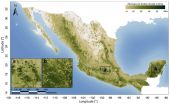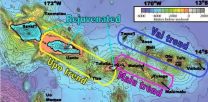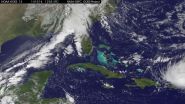(Press-News.org) NASA's Interface Region Imaging Spectrograph (IRIS) has provided scientists with five new findings into how the sun's atmosphere, or corona, is heated far hotter than its surface, what causes the sun's constant outflow of particles called the solar wind, and what mechanisms accelerate particles that power solar flares.
The new information will help researchers better understand how our nearest star transfers energy through its atmosphere and track the dynamic solar activity that can impact technological infrastructure in space and on Earth. Details of the findings appear in the current edition of Science.
"These findings reveal a region of the sun more complicated than previously thought," said Jeff Newmark, interim director for the Heliophysics Division at NASA Headquarters in Washington. "Combining IRIS data with observations from other Heliophysics missions is enabling breakthroughs in our understanding of the sun and its interactions with the solar system."
The first result identified heat pockets of 200,000 degrees Fahrenheit, lower in the solar atmosphere than ever observed by previous spacecraft. Scientists refer to the pockets as solar heat bombs because of the amount of energy they release in such a short time. Identifying such sources of unexpected heat can offer deeper understanding of the heating mechanisms throughout the solar atmosphere.
For its second finding, IRIS observed numerous, small, low lying loops of solar material in the interface region for the first time. The unprecedented resolution provided by IRIS will enable scientists to better understand how the solar atmosphere is energized.
A surprise to researchers was the third finding of IRIS observations showing structures resembling mini-tornadoes occurring in solar active regions for the first time. These tornadoes move at speeds as fast as 12 miles per second and are scattered throughout the chromosphere, or the layer of the sun in the interface region just above the surface. These tornados provide a mechanism for transferring energy to power the million-degree temperatures in the corona.
Another finding uncovers evidence of high-speed jets at the root of the solar wind. The jets are fountains of plasma that shoot out of coronal holes, areas of less dense material in the solar atmosphere and are typically thought to be a source of the solar wind.
The final result highlights the effects of nanoflares throughout the corona. Large solar flares are initiated by a mechanism called magnetic reconnection, whereby magnetic field lines cross and explosively realign. These often send particles out into space at nearly the speed of light. Nanoflares are smaller versions that have long been thought to drive coronal heating. IRIS observations show high energy particles generated by individual nanoflare events impacting the chromosphere for the first time.
"This research really delivers on the promise of IRIS, which has been looking at a region of the sun with a level of detail that has never been done before," said De Pontieu, IRIS science lead at Lockheed Martin in Palo Alto, California. "The results focus on a lot of things that have been puzzling for a long time and they also offer some complete surprises."
INFORMATION:
IRIS is a Small Explorer mission managed by NASA's Goddard Space Flight Center, in Greenbelt, Maryland for the agency's Science Mission Directorate at NASA Headquarters. NASA's Ames Research Center in Moffett Field, California, provides mission operations and ground data systems. The Norwegian Space Centre is providing regular downlinks of science data. Lockheed Martin designed the IRIS observatory and manages the mission for NASA. The Harvard-Smithsonian Center for Astrophysics in Cambridge, Massachusetts, built the telescope. Montana State University in Bozeman designed the spectrograph. Other contributors for this mission include the University of Oslo and Stanford University in Stanford, California.
For more information about IRIS, visit:
http://www.nasa.gov/iris
Videos can be found here: http://www.nasa.gov/content/goddard/iris-helps-explain-heating-of-solar-atmosphere/index.html
Parasitic bacteria were the first cousins of the mitochondria that power cells in animals and plants – and first acted as energy parasites in those cells before becoming beneficial, according to a new University of Virginia study that used next-generation DNA sequencing technologies to decode the genomes of 18 bacteria that are close relatives of mitochondria.
The study appears this week in the online journal PLOS One, published by the Public Library of Science. It provides an alternative theory to two current theories of how simple bacterial cells were swallowed ...
The need for food, animal feed and fuel in the Sahel belt is growing year on year, but supply is not increasing at the same rate. New figures from 22 countries indicate falling availability of resources per capita and a continued risk of famine in areas with low 'primary production' from plants. Rising temperatures present an alarming prospect, according to a study from Lund University in Sweden.
The research has investigated developments between the years 2000 and 2010 in the Sahel belt, south of the Sahara Desert. Over this ten-year period, the population of the region ...
Cold Spring Harbor, NY – How many times have we seen Superman swoop down from the heavens and rescue a would-be victim from a rapidly oncoming train?
It's a familiar scenario, played out hundreds of times in the movies. But the dramatic scene is reenacted in real life every time a cell divides. In order for division to occur, our genetic material must be faithfully replicated by a highly complicated machine, whose parts are tiny enough to navigate among the strands of the double helix.
The problem is that our DNA is constantly in use, with other molecular machines ...
Available for download today, the Woods Hole Research Center (WHRC) and Allianza MREDD+ released the first detailed map of aboveground forest carbon stocks of Mexico. This carbon stock inventory is very valuable for Mexico, as one of the first tropical nations to voluntarily pledge to mitigation actions within the context of the United Nation's Reducing Emissions from Deforestation and forest Degradation (REDD+) program.
The hectare-scale map is the result of a collaboration led by WHRC scientists Josef Kellndorfer and Oliver Cartus with Mexico's National Forestry Commission ...
1. Conventional medical centers may be unable to prevent spread of Ebola
A group of infectious disease experts suggests that conventional U.S. medical centers are unprepared and ill equipped to manage Ebola and a national network of specialized containment and treatment facilities may be needed to reduce the virus' spread, according to an article being published in Annals of Internal Medicine. Despite efforts from the Centers for Disease Control and Prevention (CDC) to prepare hospitals for Ebola, enormous challenges remain. The authors express doubt that conventional ...
A UC Santa Barbara geochemist studying Samoan volcanoes has found evidence of the planet's early formation still trapped inside the Earth. Known as hotspots, volcanic island chains such as Samoa can ancient primordial signatures from the early solar system that have somehow survived billions of years.
Matthew Jackson, an associate professor in UCSB's Department of Earth Science, and colleagues utilized high-precision lead and helium isotope measurements to unravel the chemical composition and geometry of the deep mantle plume feeding Samoa's volcanoes. Their findings ...
VIDEO:
NOAA's GOES-East satellite captured this image of Hurricane Gonzalo off the U.S. East Coast on Oct. 16 at 13:07 UTC (9:07 a.m. EDT).
Click here for more information.
NASA and NOAA satellites have been providing continuous coverage of Hurricane Gonzalo as it moves toward Bermuda. NASA's Terra satellite saw thunderstorms wrapped tightly around the center with large bands of thunderstorms wrapping into it. NOAA's GOES-East satellite provided and "eye-opening" view of Gonzalo, ...
Tropical Storm Ana continued on a path to the Hawaiian Islands as NASA's Terra satellite passed overhead and gathered data on the storm. NOAA's GOES-West satellite data was compiled into a movie that showed the intensification and movement of Ana. Watches are now in effect for Hawaii.
NOAA's Central Pacific Hurricane Center (CPHC) has issued a Tropical Storm Watch for Hawaii County, Hawaii. A tropical storm watch means that tropical storm conditions are possible within the watch area, in this case within 36 to 48 hours. Life-threatening surf and riptide conditions will ...
An international team of scientists has succeeded in explaining the formation and propagation over astronomical distances of jets of matter emitted by young stars—one of the most fascinating mysteries of modern astronomy. Using a patented experimental device and large-scale numerical simulations, the team obtained data consistent with astrophysical observations. The results of this research—just published in the prestigious journal Science—open up new opportunities for studying the role of magnetic fields in astrophysics and thermonuclear fusion. Bruno ...
Why is the Sun's million-degree corona, or outermost atmosphere, so much hotter than the Sun's surface? This question has baffled astronomers for decades. Today, a team led by Paola Testa of the Harvard-Smithsonian Center for Astrophysics (CfA) is presenting new clues to the mystery of coronal heating using observations from the recently launched Interface Region Imaging Spectrograph (IRIS). The team finds that miniature solar flares called "nanoflares" - and the speedy electrons they produce - might partly be the source of that heat, at least in some of the hottest parts ...






